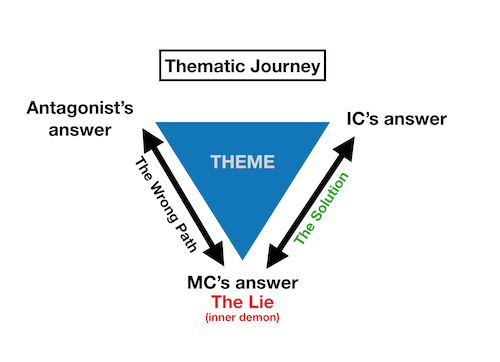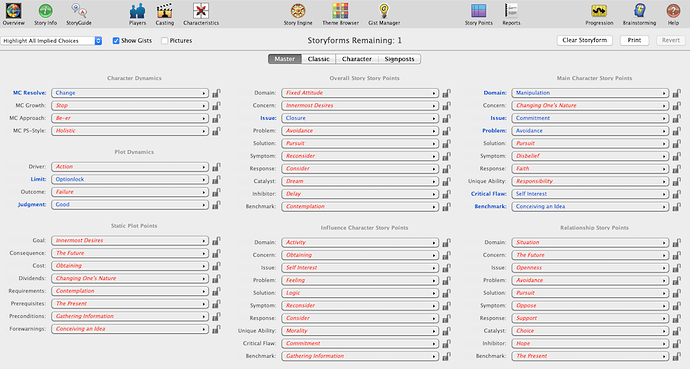I have been studying several other paradigms and trying to find the matching elements in Dramatica. In light of this, I realize I will need to rework my planned trilogy’s storyform. Specifically, I’m trying to hone down the ANTAGONIST for each book, and the “lie” they represent.
While the big story is very clear in my head, the main antagonist is a group/way of thinking, so in the first and second book the MC faces off with the henchmen/proxies (“himself” and "Darth Vader, so to speak), and the final book she faces off with the head (the “Emperor” so to speak).
But I’m stuck with finding WHERE TO CATEGORIZE THIS “LIE CONFLICT” IN THE STORYFORM.
In particular, I have highlighted the following information about the antagonist and his relationship with the lie/goal of the MC:
The Antagonist makes the story. He wants the same thing the protagonist wants. The “soul” of the city.
ANTAGONISTS THINK THEY’RE THE PROTAGONISTS
The protagonist wants to free the slaves; the antagonist wants to keep them and the power they provide. The protagonist wants to rescue the hostages; the antagonist wants to keep the hostages, or worse, kill ’em. The protagonist wants a chalupa; the antagonist has stolen ALL THE CHALUPAS. The antagonist can oppose the main character directly, seeking to undo her efforts; or the antagonist can oppose her indirectly, coming at the story at an oblique angle (but still clashing with our protagonist character).
the biggest and best test of an antagonist is that I want to a) love to hate them and/or b) hate to love them.
- Does this character start out either
- believing basically the same Lie as the protagonist?
- believing a Truth contrary to the protagonist’s Lie?
- Is this character painfully similar to the protagonist in some ways?
- Is this character an example of either
- someone the protagonist would desperately like to be?
- someone the protagonist desperately wants to avoid being (or perhaps already is)?
- Will this character be able to offer convincing thematic arguments with the potential to seduce the protagonist away from the story’s Truth—and, as a result, away from his story goal?
Ask yourself:
- What character best represents where the protagonist will end up if he takes the wrong path?
- What character best represents where the protagonist wants to end up externally?
- What character shares a similar backstory journey with your protagonist?
- What character represents or shares similarities with your protagonist’s greatest failures to date?
Ask yourself:
- What antagonist will be present in the Climax’s final confrontation?
- How can this antagonist be the major opposing force against the protagonist at all of the major structural beats?
- How can this antagonist be set up as an obstacle (or the inevitable potential for an obstacle) from the very first scene?
- How will the protagonist “brush” against this antagonist’s power in the Inciting Event?
- How will this antagonist drag your character into the main conflict at the First Plot Point?
(from KM Weiland website, Story Engineering, etc)
It is clear that the Influence Character in Dramatica is the one who challenges the lie.
In this video: it shows the sidekick as the one whose words challenge the lie, which means Sidekick=influence character.
It also hints at a TRIAD of Sidekick-MC (lie) -Antagonist whose thematic messages hit the MC from two sides, like an upside-down love triangle trying to win the MIND (not heart) of the MC.
Here’s what I seem to understand:

MY GUESS: OVERALL STORY ISSUE is the Truth, MC ISSUE is the lie, problem is the MC’s answer to the lie.
Or is the lie the “critical flaw”?
And where, then, does the Antagonist’s goal (juxtaposed lie) fit?
Here’s what I came up with, assuming Issue=lie category, problem=MC answer.
But here’s what I came up with, starting with her unique ability, then spinning “Critical Flaw” with the lie.


